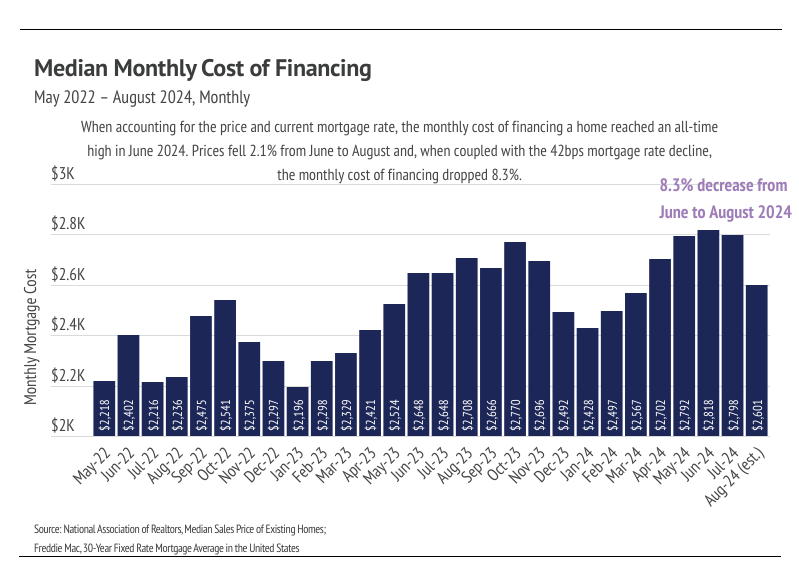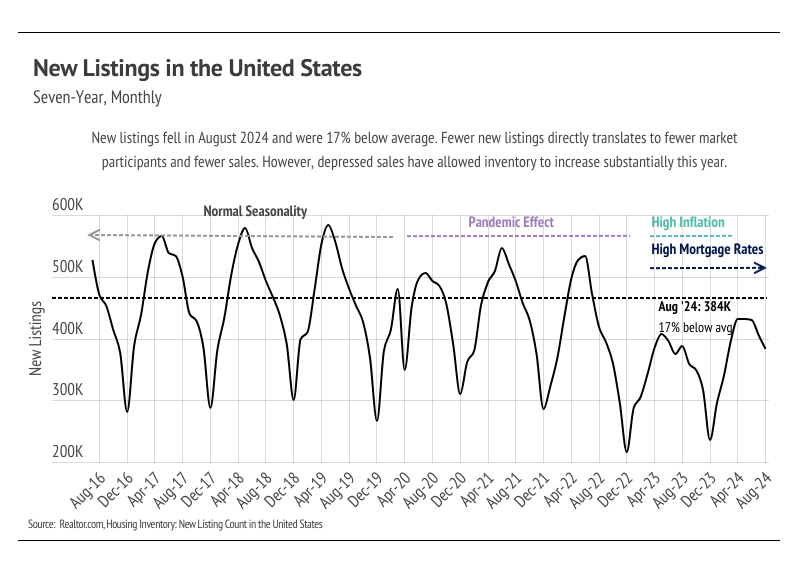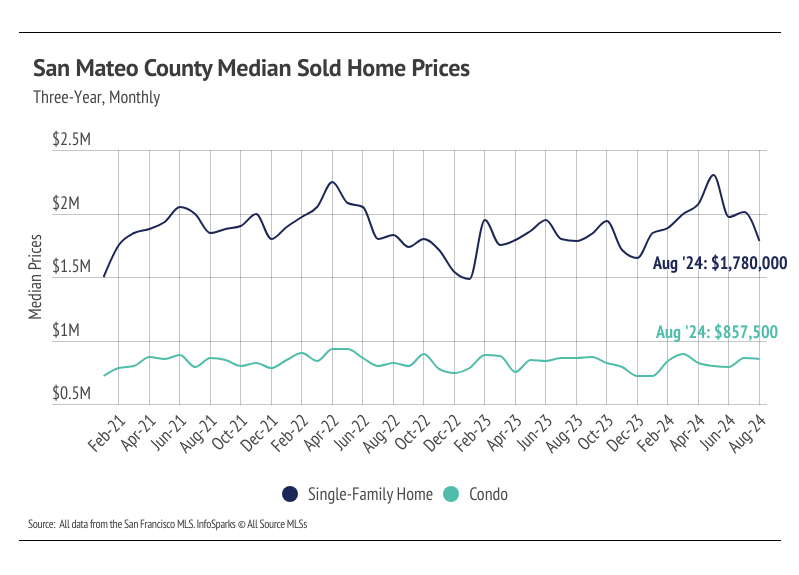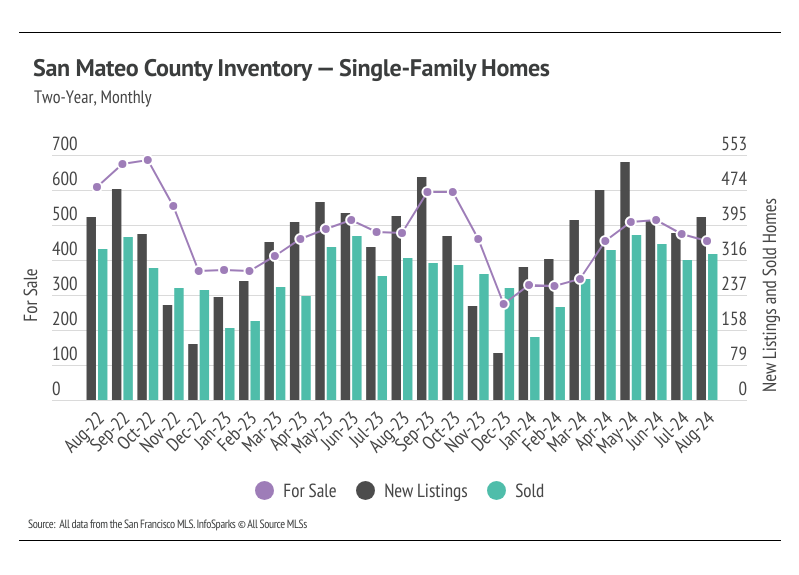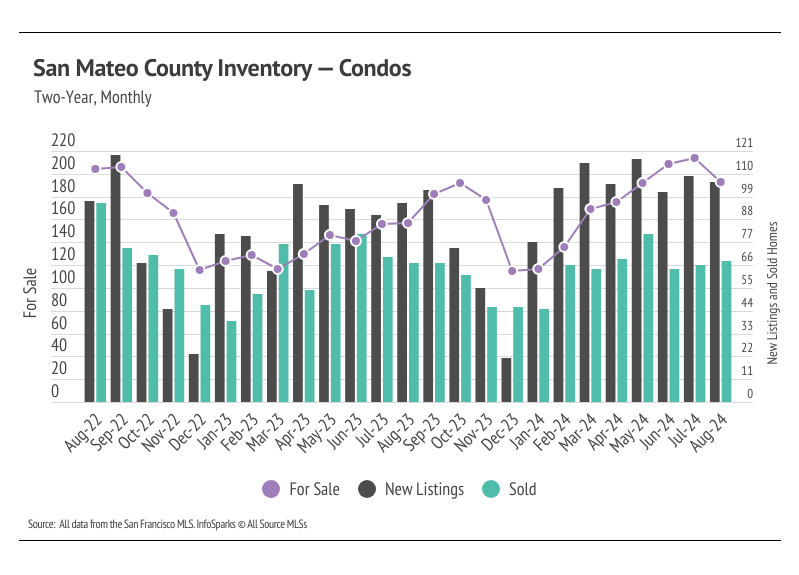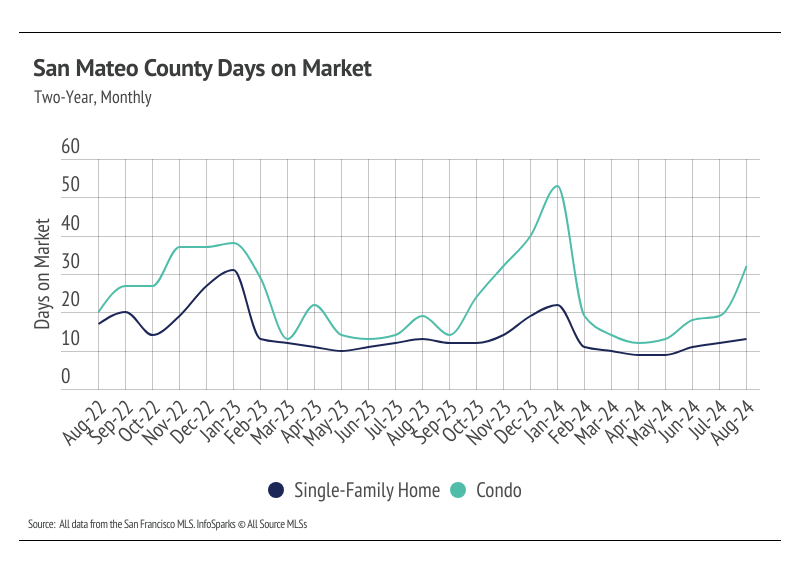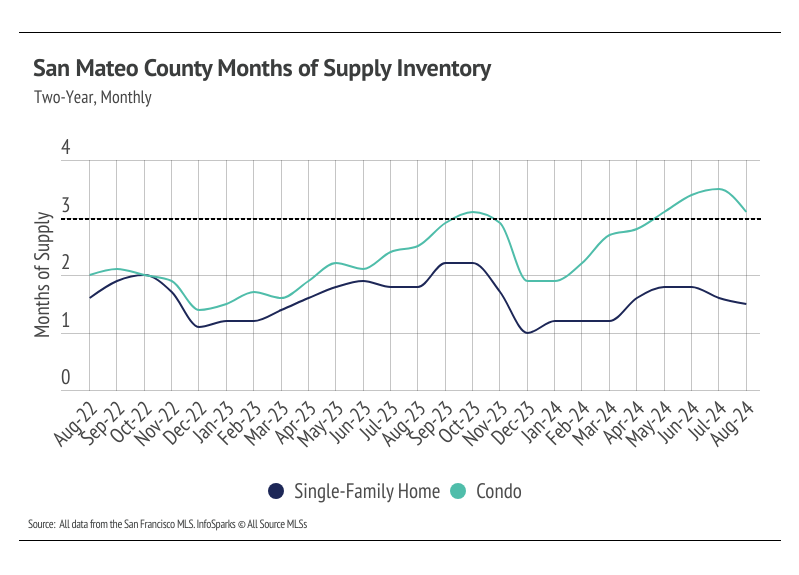If you prefer to bypass The Big Story and jump straight to the Local Market Report, click here.
The Big Story
Lower Prices and Lower Mortgage Rates
Quick Take:
- Nationally, the monthly cost of financing a median-priced home was 8.3% lower in August 2024 than in June because the median home price declined 2.1% over the past two months, and mortgage rates have dropped.
- In August, the average 30-year mortgage rate declined for the third month to 6.35%, a 0.87% drop from the 2024 high reached in early May. The Fed is expected to cut rates by at least 0.25% in its September 17-18 meeting. Rate cuts will benefit the current market.
- Sales rose 1.3% month over month, ending a streak of four consecutive monthly declines, while inventory rose to its highest level since 2020. Because sales have been so sluggish this year, we may see sales increase in the fall, as rates fall and homes become more affordable.
Note: You can find the charts & graphs for the Big Story at the end of the following section.
*National Association of REALTORS® data is released two months behind, so we estimate the most recent month’s data when possible and appropriate.
Affordability matters. Go figure!
Despite low affordability through June 2024, affordability began improving in August 2024. The median U.S. home price reached a record high in June 2024, as did the monthly cost of financing a median-priced home, even though mortgage rates weren’t quite at their highest level this year. In other words, affordability hit a record low in June. Generally, prices tend to peak in June during any given year, even though the market veered away from this seasonality for a few years during the pandemic. It was no surprise, therefore, when prices declined slightly in July and August of this year. Additionally, during July and August, inflation lowered meaningfully, which means rate cuts. The anticipation of rate cuts alone led to lower rates in July and August. Over the past two months, the average 30-year mortgage rate fell 0.51%, which drastically improved affordability.
A rough but decent shorthand calculation for mortgage rates is that every 0.10% increase or decrease to mortgage rates equates to roughly a 1% increase or decrease in the monthly mortgage cost. This means that, over the past two months, the monthly payments on homes became approximately 5% cheaper.
Sales and inventory generally also decline in the second half of the year. However, this historical trend has broken over the past couple of years. Sales have been historically low since January 2023; so, even though new listings have also been depressed, inventory has grown to its highest level since 2020. At this moment, homebuyers have more choice than they’ve had in years. Higher supply, lower price, and lower interest rates caused sales to increase month over month, albeit only slightly — up 1.3%.
Sales may continue to increase, however, because of the improving conditions, and sales levels are so low they almost have nowhere to go but up. The mid-September Fed meeting will likely bring about the first in a series of rate cuts, and the housing market may fare extremely well next year due to the timing of the cuts. The inventory build-up will likely slow for the rest of the year; but, since it’s already grown substantially, that isn’t concerning. We expect to enter 2025 with falling rates, high inventory, and seasonally lower home prices, which should create a perfect storm for a hotter spring market. We realize spring is a bit far; but, until then, we expect the sluggish market we’ve experienced over the past two years to persist, at least in terms of sales. The current market is favoring buyers, so if you’re thinking of buying, we can at least say that you have the most options to choose from.
Different regions and individual houses vary from the broad national trends, so we’ve included a Local Lowdown below to provide you with in-depth coverage for your area. As always, we will continue to monitor the housing and economic markets to best guide you in buying or selling your home.
Big Story Data
The Local Lowdown
Quick Take:
-
The median single-family home price fell 11.4% month over month, while condo prices declined 0.2%. We expect price contraction for the rest of the year, which is the seasonal norm.
-
Total inventory fell 10.3% month over month, as sales and homes under contract far outpaced new listings. We expect inventory to decline and the overall market to slow as we make our way through the second half of the year.
-
Months of Supply Inventory has declined month over month, indicating the market is improving for sellers. Currently, MSI indicates a sellers’ market for single-family homes and a balanced market for condos.
Note: You can find the charts/graphs for the Local Lowdown at the end of this section.
Median home prices declined month over month, which is the seasonal norm
In San Mateo, home prices haven’t been largely affected by rising mortgage rates after the initial period of price correction from April 2022 to January 2023. Since January 2023, the median single-family home and condo prices have trended horizontally. Year over year, the median price declined marginally, down 0.3% for both single-family homes and condos. Single-family home prices peaked in April 2022, and condo prices peaked in May 2022; they are currently at 21% and 8% below peak, respectively. Prices are more likely to rise if more sellers come to the market. Inventory is so low that rising supply will only increase prices as buyers are better able to find the best match. More homes must come to the market to get anything close to a healthy market. That said, inventory, sales, and price typically peak in the first half of the year, so we expect contraction across those metrics for the rest of the year. Inventory is still low enough that it should create price support as supply declines in the second half of the year.
High mortgage rates soften both supply and demand, but home buyers and sellers seemed to tolerate rates near 6% much more than around 7%. Now that rates are declining, sales could get a little boost, but the housing market typically begins to slow as we make our way into fall.
Sales and new listings rose, while inventory fell in August
In August, inventory declined, which is normal for this time of year, while sales and new listings rose. Compared to this time last year, inventory has increased slightly, up 3%. Sales are up 3% for single-family homes and 2% for condo. Any amount of new listings are good for the San Mateo market. Inventory still has a long way to go before the market begins to become more balanced. When we take a longer look back and compare the supply of homes in August 2019 (pre-pandemic) to now, active listings have decreased by 30%. With that in mind, it should be no surprise that sales have declined by 25%.
Total inventory has trended lower essentially since 2010, but active listings fell precipitously from October 2020 to December 2021, as sales increased dramatically during that period, before stabilizing from January 2022 to the present at a depressed level — still 20% lower than two years ago. Low inventory and new listings, coupled with high mortgage rates, have led to a substantial drop in sales and a generally slower housing market. Typically, inventory begins to increase in January or February, peaking in July or August before declining once again from the summer months to the winter. In 2023, sales and inventory didn’t resemble the typical seasonal peaks and valleys. It’s looking like 2024 inventory, sales, and new listings will follow historically seasonal patterns, albeit at a depressed level. It’s clear that supply will remain tight until spring 2025 at the earliest.
Months of Supply Inventory in August 2024 indicated a sellers’ market for single-family homes and a balanced market for condos
Months of Supply Inventory (MSI) quantifies the supply/demand relationship by measuring how many months it would take for all current homes listed on the market to sell at the current rate of sales. The long-term average MSI is around three months in California, which indicates a balanced market. An MSI lower than three indicates that there are more buyers than sellers on the market (meaning it’s a sellers’ market), while a higher MSI indicates there are more sellers than buyers (meaning it’s a buyers’ market). The San Mateo housing market tends to favor sellers, which is reflected in its low MSI, especially for single-family homes. MSI has been below three months since April 2012 (2012 is not a typo!) for single-family homes. Over the past two years, MSI has risen meaningfully for condos. In August, condo MSI indicated a balanced market, while single-family home MSI still implied a strong sellers’ market.


